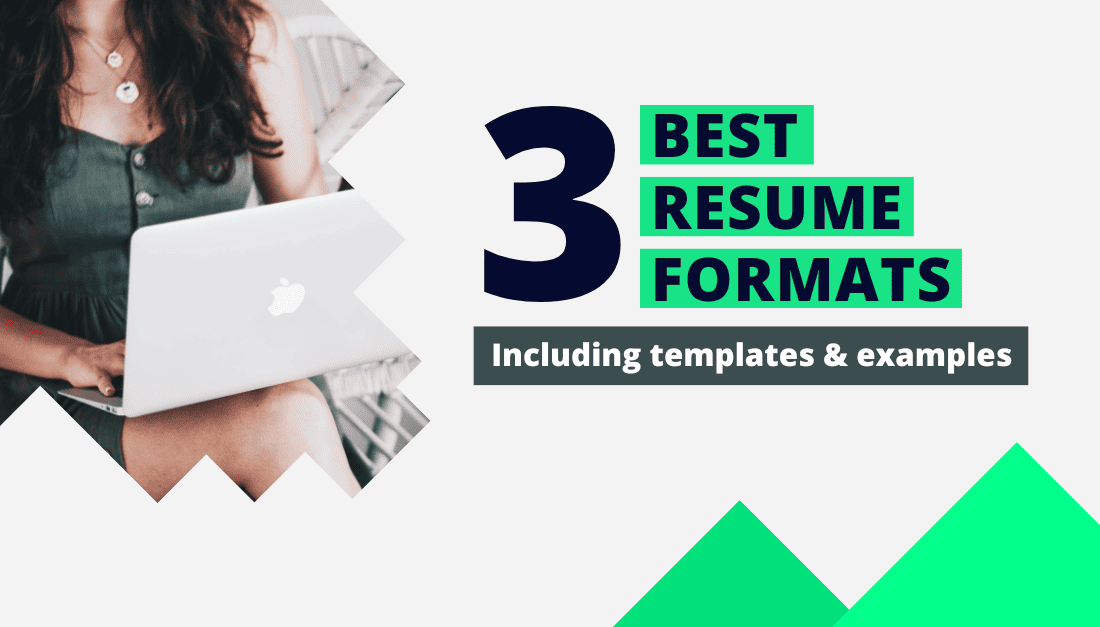
3 Best Resume Formats That Will Get You Noticed and Hired Faster
Most people I talk to have an incredibly difficult time putting together a job-winning resume.
Don’t get me wrong, you may be incredibly capable, you may have a wealth of experience to share, and once you get an interview you may be a star candidate.
But, putting all your skills down on paper, that’s a totally different story.
Well, you're not alone.
In fact, in a recent survey, 47% of job seekers said that presenting their experience was the #1 struggle they faced when it comes to their job search.
This struggle is very real and is definitely confirmed on the other side of the hiring equation too, with 56% of hiring managers reporting that very few resumes they've seen were well-written.
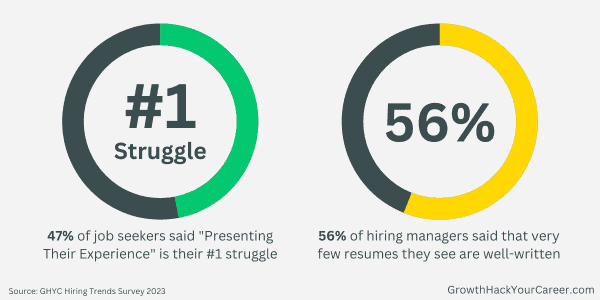
On the bright side, this isn't an impossible problem to solve. Oftentimes, the issue lies in the fact that you're trying to fit a square peg in a round hole. In other words, you're trying to fit your experience and skills into a resume format that isn't suitable for you.
If you’re thinking, “wait, there’s more than one type of resume format?” This post is for you.
In this post, I’ll break down:
- The 3 different types of resume formats
- The best resume format for each career stage
- And how to choose the resume format that’s best for you
I'll also give you examples of great resumes for recent college grads, early-career job seekers, career changers, and highly experienced professionals.
Alright, let’s jump right in!

What’s the Best Resume Format?
If you're a professional with 5-10 years of experience, the chronological resume format is probably the best choice for you. However, that doesn't mean you should limit yourself to just this resume format without considering the other two options (functional and combinational).
Most people automatically choose the chronological resume format because it’s what they're familiar with and what gets taught in schools. But, depending on your experience and the type of job you're applying for, one of the other two formats might be a better fit.
Your experience, skillset, type of position you're applying for, and many other factors come into play when deciding on the best resume format for you.
So let’s break down each resume format so you can decide which is actually the best for you.
3 Types of Resumes
As mentioned above, there are three types of resumes to pick from: chronological, functional, and combinational. To hone in on the best type of resume for you, ask yourself these questions:
- Is my best experience my most recent experience?
(Is your most impactful role your current role, or was it in the past?) - Do I have too little or too much experience?
(Too little experience is considered 0-2 years, too much could be 10+ years) - Has my career grown linearly or do I have a wide range of experience?
(Have you grown in the same role or do you have experience in many different fields?)
Before you spend hours on editing your resume and sweating every little detail, it can be helpful to reflect on these questions.
👉 Note: If you’ve already created a resume, not to worry. You can easily change your resume by using one of these recommended resume builders that let you reformat it in seconds. If you’ve never used a resume builder before, I highly recommend switching to one as it will give you a lot more flexibility.
Alright, now let’s break down each type of resume based on the questions above.

Chronological Resume Format: Most Popular Resume Format but Not Always the Best
The chronological resume format is the one that 99% of people choose to use. But that doesn’t necessarily mean it’s the best format.
A chronological resume format lists your work experience in reverse chronological order, starting with your most recent job and moving backward from there.
The reason that so many people are inclined to use this format is because it’s the standard format that most resume templates force you into.
Generally, chronological resumes are neat and structured, but if you're someone with a lot of experience, this format can actually make your resume look messy. In addition, it prioritizes recent experience over older experience, which isn't always ideal if your best work happened 5 or 10 years ago.
👉 In that case, your best experience ends up getting buried at the bottom of your resume.
In contrast, if you're a relatively fresh grad and you’ve only had 1-2 jobs, this format can make your resume look short, sparse, and underwhelming.
If you’re not sure whether this format is best for you, I recommend watching this video by Matt Warzel, a Certified Professional Resume Writer (CPRW), where he explains how to make the best use of it.
Chronological Resume Format Templates and Examples
A chronological resume format can definitely make for a strong resume, but there are some important formatting tips you should keep in mind.
Based on the thousands of job seekers I’ve worked with, here are some of the most important elements to make a chronological resume shine:
- SKILLS SECTION: Make sure you put your skills section near the top. Recruiters will typically only spend 10-30 seconds reviewing your resume, so you want to make sure they can see your best skills right away.
- RESUME SUMMARY: To stand out from all the other chronological resumes, it’s best to include a unique and creative resume summary. I recommend placing this right below your name and use this guide to write an eye-catching resume summary.
- EDUCATION SECTION: Your education section should typically be at the bottom of your resume. Don’t forget to include any degrees or certifications that can add value to the position you are applying for.
Here is an example of my chronological resume that I used to land roles at multiple companies (including a Fortune 500 company):
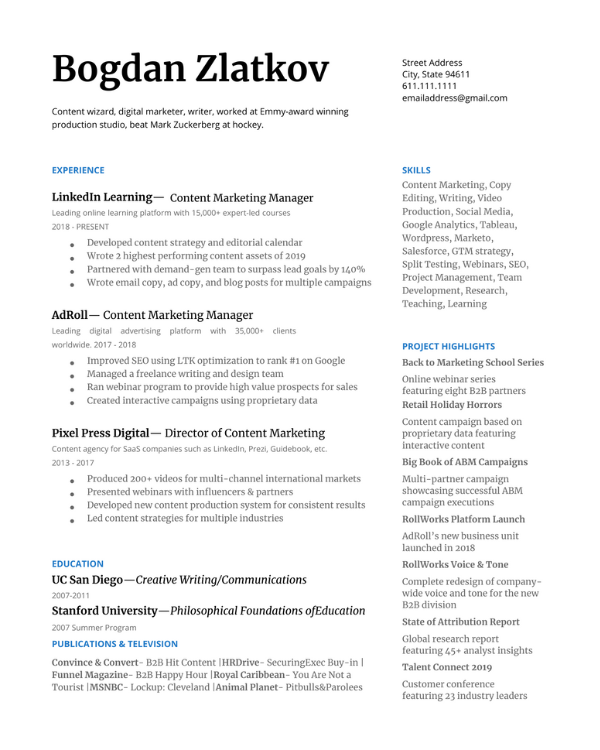
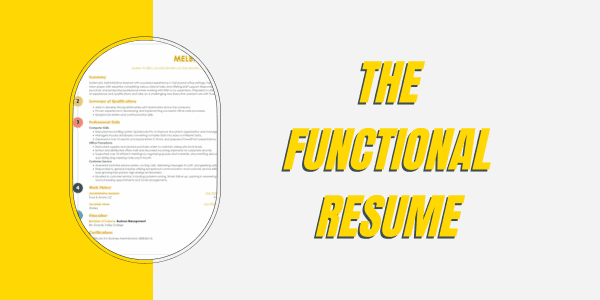
Functional Resume Format: Best Resume Format for Early Career & Career Changers
The second most popular resume format is the functional resume. This type of resume focuses on the skills and qualifications you possess, rather than your employment history or job titles.
I love this resume format because it lets you highlight transferable skills from one job to another and showcase your work experience without having to list every single job you’ve ever had.
This type of resume is especially helpful for job seekers who are:
- Entering the workforce for the first time (first-time job seekers)
- Transitioning to a new career or industry
- Have large gaps in their employment history
Functional resume templates help with these three situations by ignoring the traditional “work experience” section and replacing it with a “Qualifications” and “Skills” section instead.
This takes the focus away from your employment history and instead focuses more on the skills you have to offer.
(Note: This resume format is especially useful for students or recent grads who may not have much work experience, but still have other types of skills they’ve learned)
Because functional resume formats aren't as common as chronological resumes, it can be difficult to know where to start when creating one. One resume builder that has some great functional resume formats is MyPerfectResume. It’s on that list of best resume builders and it makes creating a functional resume super easy.
Functional Resume Format Template and Examples
While a chronological resume template focuses mainly on dates, job titles, and employers, a functional resume template typically relies on skills and qualifications. If you decide to go with a functional type of resume, there are two sections you need to have:
- SUMMARY OF QUALIFICATIONS: This is a high-level summary of the qualifications you possess that are relevant to the job (make sure you tailor this to every job you apply to!)
- SKILLS SECTION: You want to have a skills section that has a comprehensive list of skills related to the role you’re applying for. It can sometimes be best to divide this section into multiple categories to make it easier to read (for example: “technical skills” such as software tools, and “professional skills” such as methods, etc).
Many job seekers make the mistake of abusing the skills section by adding too many soft skills or generic skills (such as “excellent communication” or “team player”).
👉 Do not add these types of skills to your resume!
If you’ve already done this, don’t worry, this is a very common mistake.
To find the right skills to add to your resume, I recommend watching this video by Matt Warzel:
It's also worth noting that there are other sections to a functional resume that you can (and should) include. It's just a matter of ordering them in the most appropriate way. Typically, these are the sections you should include:
- Resume Summary
- Summary of Qualifications
- Work History (keep this brief without no bullet points)
- Education
- Certifications/Awards
Here is an example of what a functional resume format looks like:
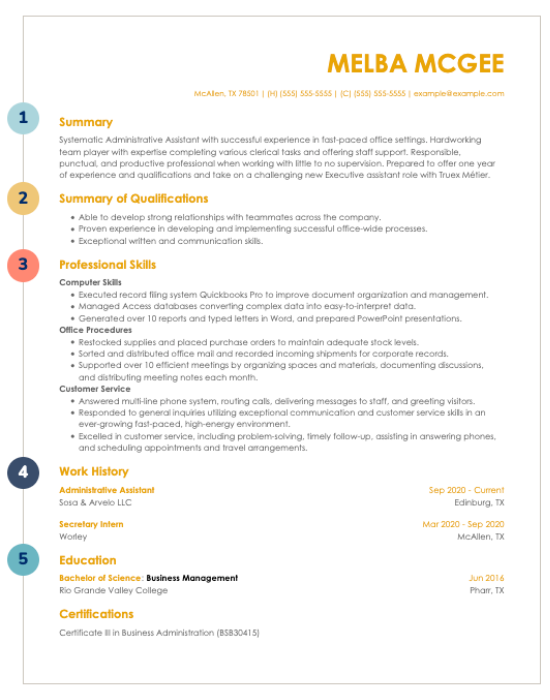
As you see, the majority of the weight is given to your qualifications and skills, but you can still include other sections as well. You can still have a resume summary, education section, and certifications section, but with a bit less focus on these parts of your background.
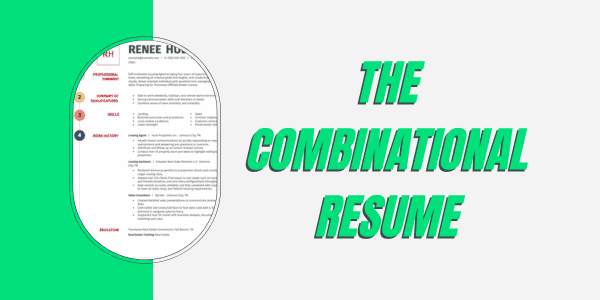
Combinational Resume Format: Best Resume Format for Career Changers or Career Gaps
As the name implies, a combinational resume includes elements of both the chronological and functional formats. It’s organized into two distinct sections that set it apart from the other two types:
- One section focuses on your relevant skills
- And another section lists your experience in chronological order
Because the two sections are well-defined, recruiters are able to quickly scan for the information they need and land on the things they’re most interested in.
There are a few particular cases where this resume format is ideal:
- If you’re switching from one career field to another
- If you’re trying to move up in seniority in your current field
- And if you’re returning to the job market after a hiatus
This type of resume is great for these situations because it lets the hiring manager see both your transferable skills and how it relates to your work history. It lets them know that you can do the job and that you have some track record of success.
This is particularly useful for those who want to make a career change.
For example, let's say you've spent 10 years working in one profession, but you’re at a stage in your life where you’d like to make a career pivot.
Many people who try to make a career pivot using a chronological resume tend to hit a roadblock because they get screened out as “unqualified” since their previous roles don’t match the job they’re applying for.
With a combinational resume format, however, you're able to highlight your transferable skills that apply to your new desired role.
If you’re thinking about making a career pivot, I highly recommend watching this video by Angie Callen, a Certified Career Coach:
Combinational Resume Format Examples and Templates
A combinational resume looks similar to a chronological resume, except that in addition to a work history section it also includes an “achievements” section.
A combinational resume emphasizes your most impressive achievements first, at the very top of your resume. This is where you have the opportunity to show what makes you stand out and why the employer should hire you.
You can watch this video from Matt Warzel for more detailed guidance on how to create a combinational resume.
Here is an example of a combinational resume template. Again, if you’d like to turn your resume into a combinational resume, but don’t want to mess with all the formatting headaches, I highly recommend using one of these four resume builders
MyPerfectResume has the template below along with many excellent combinational resume templates.
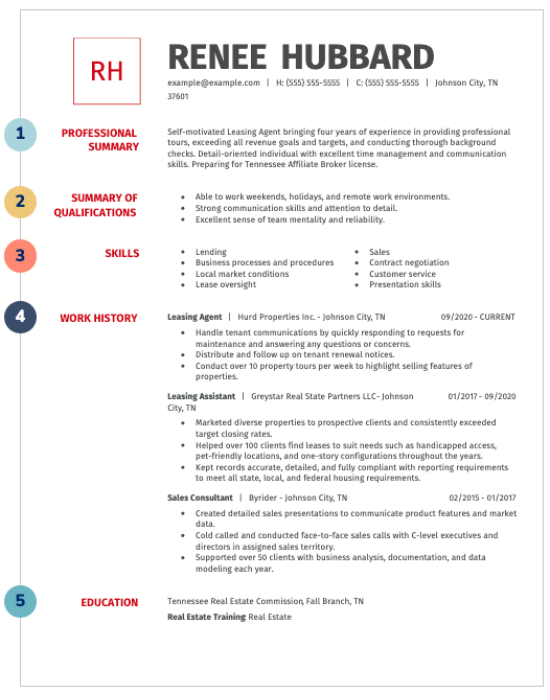
Takeaways and Next Steps
Choosing the right resume format is one of the most important steps you can take to set your job search up for success. Regardless of which of these types of resumes you choose, however, your next step should be to learn how to properly write your resume.
If you’d like guidance on how to write a modern resume, you can watch our full resume course 100% FREE.
Just drop your name and email below and you’ll get instant access to The Multi-Resume Strategy used by thousands of job seekers, ATS-friendly resume templates, step-by-step video instructions, and much more!
More from the blog:
Ultimate Career Goals Planner: How to choose your career goals (+7 examples)
Ultimate Career Goals Planner: How to choose your career goals (+7 examples)A mentor of mine once...
Good Weakness for Interview: How to Craft the Perfect Answer (+10 Examples)
Good Weakness for Interview: How to Craft the Perfect Answer (+10 Examples)One of the biggest...
Top 9 Questions for Second Interviews: What to expect & how to answer
Top 9 Questions for Second Interviews: What to expect and how to answer Congratulations! 🎉 If...
Like this? Try our free courses!
Tired of sending your job applications into a black hole and never hearing back? Get hired faster with our guided courses all for FREE!
Bogdan Zlatkov is the Founder of GHYC and author of "The Ultimate Guide to Job Hunting", ranked #1 on Google. He has been featured in the Wall Street Journal, Fast Company, HR Dive, and more. At GHYC, Bogdan creates job search courses & tools by working with award-winning career coaches, best-selling authors, and Forbes-Council members. Prior to GHYC, Bogdan led the content programs at LinkedIn Learning.
